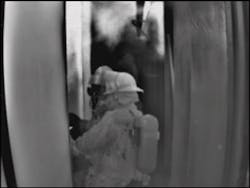Thermal Imaging Training: The Challenges in Specialty Fires
The majority of thermal imaging training focuses on thermal imager (TI) use at structure fires. This is logical, as structure fires are the most common fire response. However, a number of fire departments must plan for fires on board aircraft or ships. For example, in June 2002, Anchorage, AK, firefighters had to extinguish several vehicles on fire four levels below the main deck in order to save a 790-foot vessel from disaster. Firefighters used a TI to navigate through a dangerous and maze-like vehicle hold, avoiding structural components as well as the vehicle tie-downs in order to find the fire. In January 2003, Jacksonville, FL, firefighters fought a cargo container fire aboard a docked vessel, preventing the spread of the fire to hazardous materials. Here, firefighters used their TI to locate the fire and direct hose streams more effectively.
This month's column will concentrate on the thermal imaging challenges that firefighters can face in aircraft and ship fires.
While aircraft fires are relatively few and far between, airport rescue and firefighting (ARFF) services and municipal departments near airports face the potential for an aircraft fire every day. Proper training on response techniques, as well as the appropriate use of tools such as the thermal imager, can help ensure that if a response is needed, it is coordinated and effective.
Just as in structural firefighting, the TI can be used to assist in the size up of an aircraft incident, fire attack, search and rescue, and investigations. Despite this flexibility, there are a few challenges firefighters must remember as they train for TI use in an aircraft:
- Aircraft are constructed primarily of aluminum. Aluminum has a relatively low emissivity, meaning that it does not send its true temperature signature to the fire service TI. As a result, the metal can appear black or gray (indicating cold or cool temperatures) on the TI display, even when it may be extremely hot. This problem extends to any temperature measurement device on the TI. The temperature reading of unpainted aluminum could be off as much as 60% or 70% (see photo 1). Aluminum is also highly reflective of infrared radiation (heat), so firefighters need to be aware of how a scene may be altered by reflections of fire, victims, doors, etc.
Shipboard Fires
A shipboard fire can be a real challenge, especially for the municipal firefighter whose training and experience has primarily been in residential or commercial structures. The narrow passages, bulkhead doors, numerous deck levels and maze-like features of a vessel can be disorienting and disastrous for unprepared firefighters.
The advantages of using a TI in this environment are similar to the advantages of using the technology in an aircraft, possibly even enhanced due to how easily disorientation can occur in a vessel (see photo 2). While the threats of a ship fire may be different from those of an aircraft fire, many of the TI challenges are similar:
- Large vessels are constructed primarily of steel. Steel, like aluminum, will not show a fire service TI its true temperature. Temperature indicators will not have reliable measurements, although the error rate should be lower than it is for shiny aluminum. A bulkhead door hiding a fire may not display as white on the TI during the initial growth of the fire. However, once the steel heats up enough, the TI will help firefighters identify the location and extent of a fire, as well as the potential spread (see photo 3).
Conclusions
The advantages and uses of a TI at a structure fire are similar to the advantages and uses of a TI in aircraft or shipboard fires. However, due to the nature of the fires and the construction of aircraft and ships, the TI is more likely to face challenges not commonly encountered in a house fire. Proper training, preparation and practice will help ensure that the TI is an effective tool for firefighters, even in these difficult environments.
For additional information on these specialty fire challenges, please visit the Technology section of Firehouse.com. You can read the full accounts of the Anchorage and Jacksonville incidents online.
Jonathan Bastian is a thermal imaging training specialist for Bullard. He is certified as a thermal imaging instructor by the Law Enforcement Thermographers' Association (LETA), the international public safety organization specializing in thermal imager certification and training. He is also the author of the FD Training Network "FireNotes" book, Thermal Imaging for the Fire Service. Educated at Brown University and licensed as a high school teacher in Illinois, Bastian served 12 years on the North Park, IL, Fire Department, including the last three as a captain. As health and safety officer, he led the development and implementation of the department's rapid intervention team SOG. Bastian is a certified Fire Instructor I and Firefighter III, and he spent 12 years as an EMT-I/D. He has taught classes on thermal imaging, rapid intervention teams and search and rescue operations. He is currently a public safety official in Central Kentucky. If you have questions about thermal imaging, please send them to [email protected].
